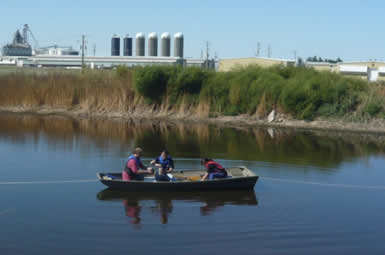
Research Profile by Dan Snow
How often does the average person think about what is in the glass of water they are drinking with dinner? Why would you ever care about the traces of pesticide residues or toxic organic chemicals produced by cyanobacteria in a lake? Who would think about the consequences of vanishingly small amounts of pharmaceuticals from livestock waste or steroid hormones in municipal wastewater?
Individually, finding traces of these and other chemicals in water and the environment seems likely to be inconsequential. But because these are all biologically active substances, they can exert effects on organisms even at the tremendously small levels at which they are found. This is one reason so much effort is devoted to developing methods to test for organic chemicals at the University of Nebraska Water Sciences Laboratory. The Lab is part of the Nebraska Water Center, a part of the Robert B. Daugherty Water for Food Institute. Part of my research as an associate professor in SNR is to direct the Water Sciences laboratory and work on new methods for measuring these and other chemicals in our water.
In graduate school I was involved in a project measuring traces of herbicides such as atrazine and metolachlor in surface water in Nebraska. We predicted that water in the Platte River, its tributaries, and lakes in eastern Nebraska would contain higher levels of these herbicides in the spring and early summer, shortly after crops had been treated with these chemicals.
Collecting samples during and after spring rainfall events helped us show that pesticide levels in the rivers were directly related to storm run-off. We later collected samples from well fields immediately next to rivers and found traces of these same herbicides in groundwater. Pesticides in spring run-off events can also get into drinking water, particularly if you look for degradation products. After application, atrazine and other herbicides are converted to a number of different chemicals, many of which are more water soluble and resistant to degradation. When we look for degradation products in water supplies we find traces of even more chemicals than when we look for the parent herbicides. While these degradation products are likely to be less toxic than the parent compounds, the fact that we find more and more residues in water leads one to wonder what the combined effects may be.
Pesticides are not the only chemicals showing up where we might not expect them. Antibiotics such as sulfas and tetracyclines, for example, are regularly used in livestock production to help prevent disease and improve feed conversion. Traces of antibiotics are excreted after use on animals and may wind up in wastewater or animal manure. Wastewater and manure is typically applied to crops or pastures as a nutrient source. A project involving scientists from agronomy, agricultural engineering and chemistry focused on the occurrence of tetracyclines in manure from cattle that was used to fertilize corn.
We found traces of oxytetracycline in manure and the soil. The method we developed also included some of the oxytetracycline degradation products, and allowed us to monitor degradation of the parent compound in soil. We found that these degrade over time and because they are not very water soluble tend to stick to the soil particles.
This method was later modified to include both human and veterinary antibiotics and is now being used to follow antibiotic degradation and persistence in synthetic laboratory prepared wastewater used to irrigate food crops. One large question is whether the presence of low levels of antibiotics in water or soil can lead to an increase in antibiotic resistance of bacteria. A group of UNL faculty and students from engineering and agronomy and funded by a grant from the USDA National Institute of Food and Agriculture (NIFA) is now working on this question. The research requires both chemical and microbial analysis of water, soil and vegetables to help understand the potential occurrence of antibiotic-resistant bacteria in irrigated food crops.
Methods for detection of water soluble pesticide degradation products and antibiotics require specialized equipment. Liquid chromatography tandem mass spectrometry, or LC-MS/MS, is the best method for accurate and reliable measurement of these compounds. Though expensive to purchase and maintain, this equipment is available at the Water Sciences Laboratory. LC-MS/MS equipment at the lab has been used for research projects focused on measuring these and other chemicals ranging from synthetic steroids in manure and wastewater to naturally produced cyanotoxins in lake water and fish. Each chemical or group of chemicals typically needs a new method tailored to both the properties of the compounds and the sample type.
It is often amazing to me that we are able to measure chemicals at such low levels with this technology. Because each project has a different focus, we spend a lot of time and effort devising and tailoring methods that will provide reliable results at vanishingly small levels. Because of the implications of the results, we have a tremendous responsibility to use this equipment to produce data of the highest quality. My job is to make sure that we continue to do so now and in the future.